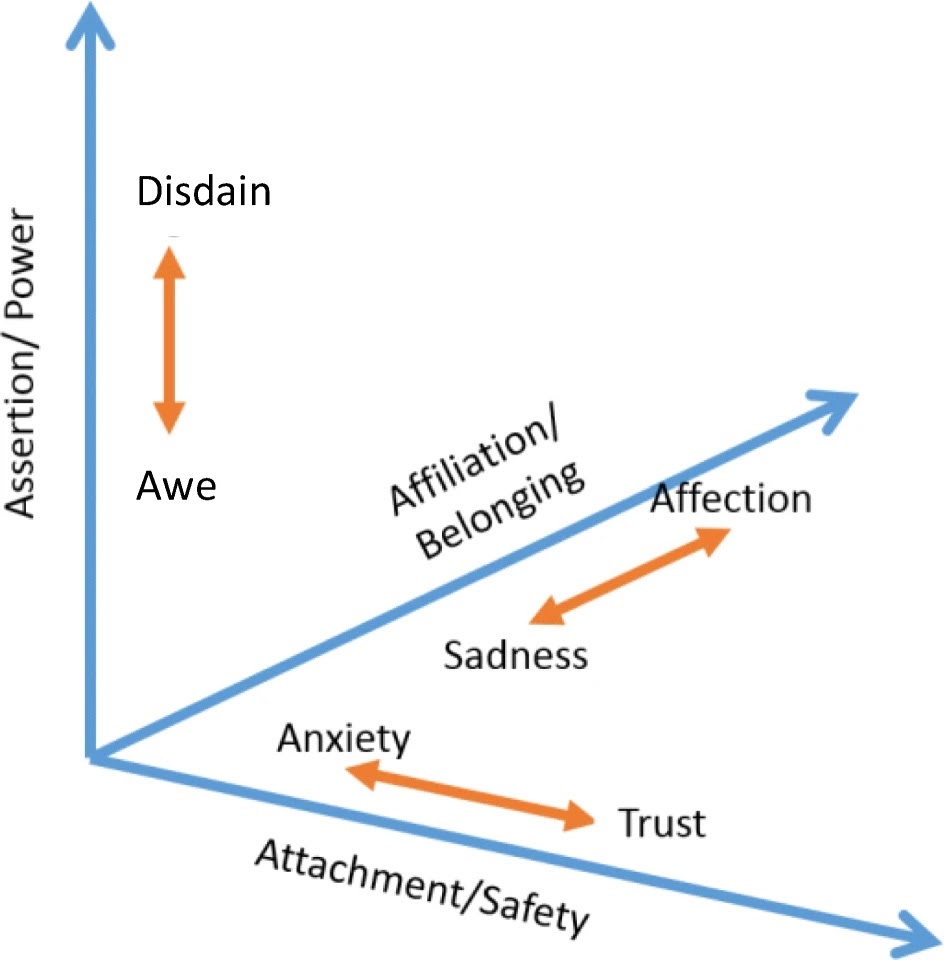
Recentering relationships for learning
Students thrive in our classrooms when they connect with each other, with the subject matter, with themselves and with us (Quinlan, 2016). Positive connections motivate student engagement and improve academic performance. This was true before the pandemic, when we could respond to facial cues during lecture, and it is true now – even as the reality of the pandemic demands we distance ourselves from one another.
In a recent study by Tormey (2021) they offer a three-dimensional framework to explain how instructors connect with students. In addition to warmth and friendliness (“affiliation”), we can strengthen our relationships with students through “attachment” or trust and “assertion” or their perception of our status/expertise. Below, we’ll briefly explore each dimension and suggest simple practices you can use to strengthen relationships with students.

Visualization of three-dimensional emotional space. Note: Adapted from “Rethinking student-teacher relationships in higher education: a multidimensional approach” by Roland Tormey, 2021, Higher Education, 82, p. 998.
Affiliation/Belonging
Students connect with teachers who are friendly and show that they listen and care. These behaviors come naturally to some of us; they might even be the qualities that brought us to the teaching profession. Regardless, at this point in the pandemic many of us are at capacity in this relationship dimension. How can we offer this sense of care without draining ourselves?:
- Address students by name when you talk or write to them – including when giving feedback on assignments.
- Survey students this week about their goals for the class and barriers they anticipate. Keep the survey anonymous, but acknowledge what you learn to the class as a whole (“I know that many of us are juggling school with families and work …”) and use it to inform your decision-making.
- Rather than restrict your personal introduction to the first day of class, share relevant stories and/or interests throughout the semester.
Attachment/Safety
We thrive in relationships with people that we trust. You can gain students’ trust by communicating clearly and following through on commitments you make.
- Before your first major assignment, review what you are expecting and how you will evaluate the work. Will you use a rubric? When can students expect a grade and feedback? If you’re not able to return work within the promised timeframe, communicate with students and reset expectations.
- Ask for feedback from students, maybe through a midterm survey, and share with them how you are adjusting the course in response.
Assertion/Power/Status
Finally, we connect with students by assuring them of our expertise in our fields, inspiring awe and respect. You might target this dimension by sharing relevant parts of your current/past research or even demonstrating your mastery by helping students see a current event through your disciplinary lens. It may feel counterintuitive to “show off” like this because in this dimension, demonstrating distance between teacher and student is what strengthens the relationship. However, having established our expertise, we can share this power by expressing pride for student achievement and confidence in their abilities as they learn.
This week, as we meet our students for the first time in the midst of worldwide uncertainty, let’s refocus on each other. Many of us are struggling, are missing the way it used to be, seeing the spark in a student’s eye as they engaged with our teaching. These relationships remain key to the learning experience and we can grow them according to our capacity and values by strategically focusing across these dimensions.
Resources:
Quinlan, K. (2016). How Emotion Matters in Four Key Relationships in Teaching and Learning in Higher Education. College Teaching. 64. 1-11.
Tormey, R. (2021). Rethinking student-teacher relationships in higher education: a multidimensional approach. Higher Education. 82, 993–1011.

Kendell Newman Sadiik
Associate Director of Transformative Teaching
Instructional Designer
LION Liaison



